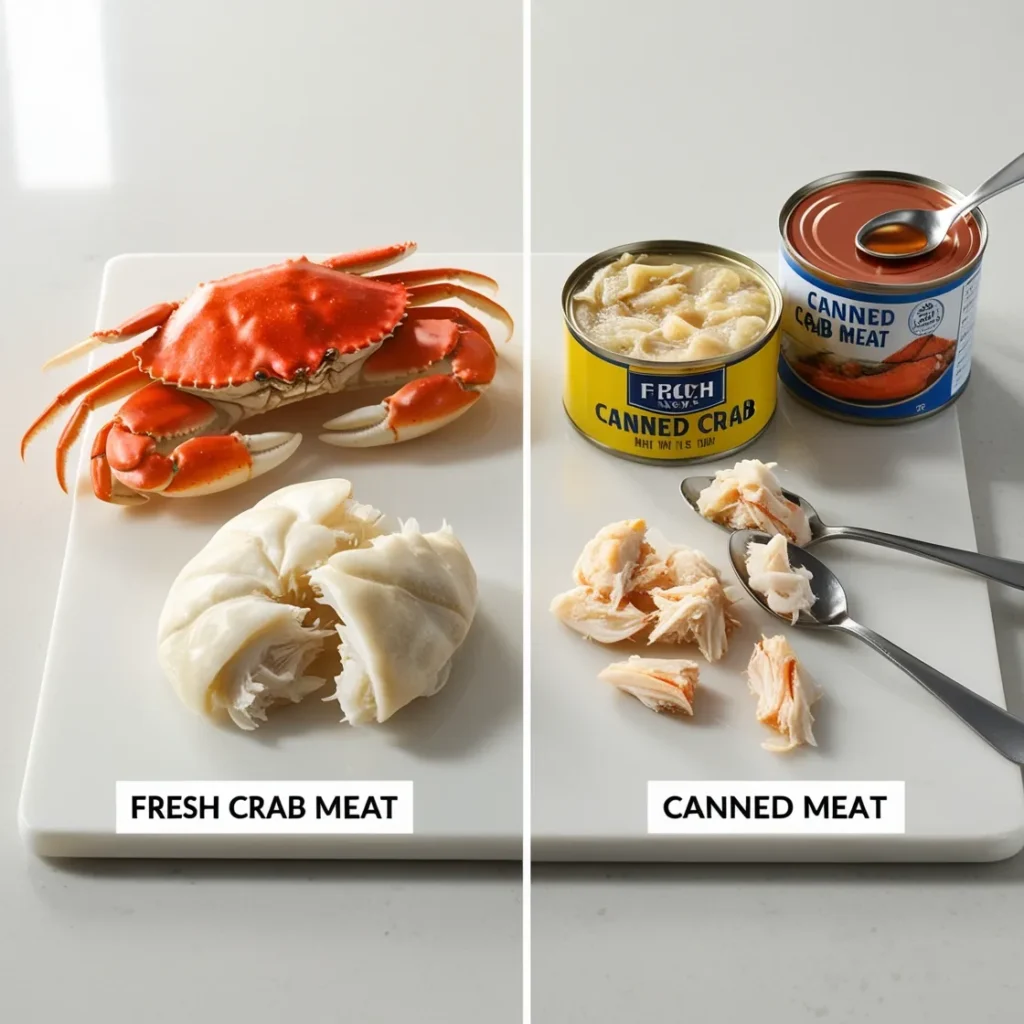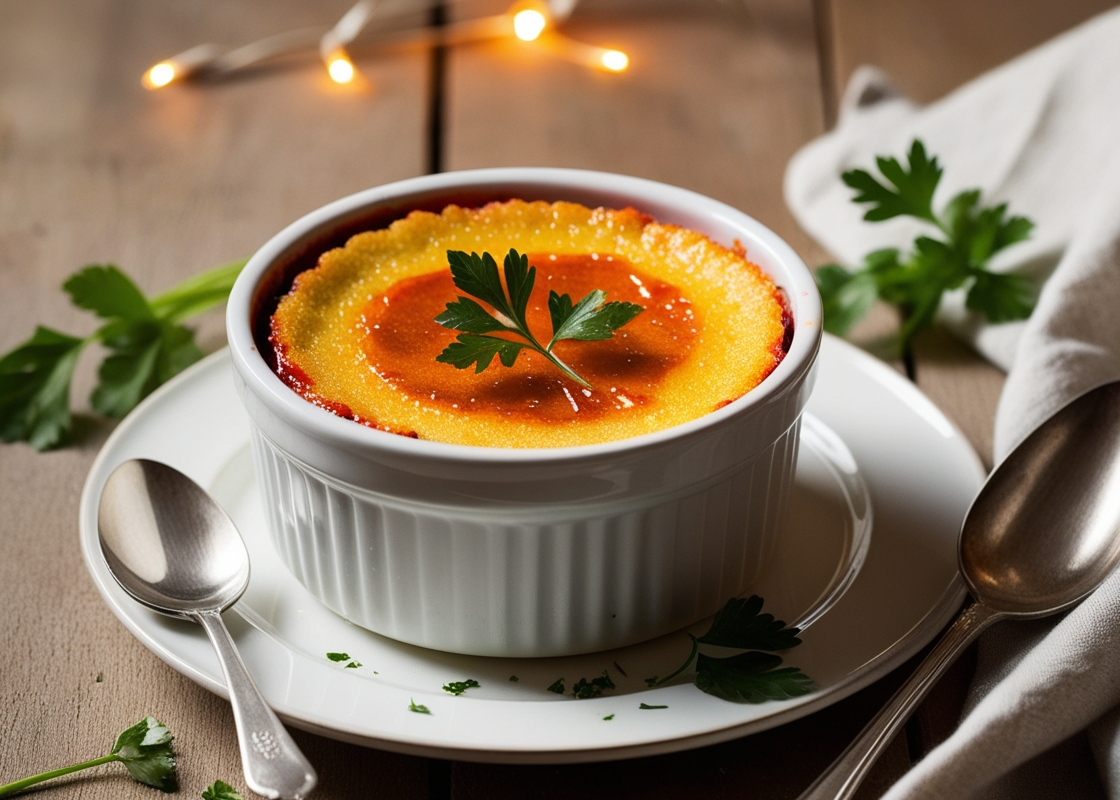Introduction
If you’ve ever wanted to savor a gourmet dish, the Crab Brulee Recipe is an impeccable choice. By combining the creamy decadence of a classic crème brûlée with the delicate, savory flavor of crab, this dish stands out as a true showstopper. Whether you’re looking to impress your guests or indulge yourself, this crab custard recipe strikes the perfect balance between elegance and simplicity. From selecting the freshest crab meat to mastering the caramelized topping, this comprehensive guide will cover every step to help you create a culinary masterpiece. Let’s begin by diving into the origins of this unique dish and uncovering what makes it so irresistible.
Jump ahead to:
What is Crab Brulee?
The Crab Brulee Recipe takes a bold and savory twist on the classic crème brûlée. By pairing rich crab meat with a creamy custard base, then topping it with a caramelized sugar crust, it creates an appetizer like no other. This dish offers a delightful contrast in textures—the crisp, golden topping beautifully complements the smooth, seafood-infused custard beneath. Each bite strikes the perfect balance of salty and sweet, creamy and crunchy.
Furthermore, this recipe showcases innovation in cooking. It blends dessert-making techniques with the bold, briny flavors of seafood, resulting in a dish that feels luxurious yet approachable. Whether you’re crafting it for a cozy evening or a grand celebration, this crab custard recipe guarantees a memorable experience.
This dish embodies innovation in cooking, blending the techniques of dessert-making with the bold flavors of seafood. Whether for a special occasion or a cozy night in, crab custard recipes like this one provide a deliciously memorable experience.
Why Crab Brulee is Gaining Popularity
The Crab Brulee Recipe has gained significant traction among food lovers, thanks to its creative presentation and versatility. Not only does it tantalize the taste buds, but it also pleases the eye, with its golden crust served in elegant ramekins. Moreover, chefs and home cooks alike appreciate its adaptability. You can easily tweak the spice levels, experiment with different types of crab meat, or even prepare parts of it in advance to minimize last-minute kitchen stress.
Additionally, this dish highlights how simple ingredients—like fresh crab, heavy cream, and egg yolks—can come together to create something extraordinary. It’s no wonder that crab custard recipes are carving out a niche in the gourmet world. Ready to get started? Let’s move on to selecting the best crab meat for your brulee
Fresh vs. Canned Crab Meat for Crab Brulee

When preparing a Crab Brulee Recipe, the quality of the crab meat is pivotal to the dish’s success. Typically, you’ll decide between fresh or canned crab, as both options offer distinct advantages. Therefore, understanding their differences can help you make the best choice for your recipe.
Fresh Crab Meat:
Fresh crab meat is often the go-to choice for purists. Known for its superior flavor and texture, it delivers a sweet, delicate taste that pairs exquisitely with the custard’s creamy base. Its natural brininess further enhances the savory notes, making it ideal for those craving an authentic seafood experience. However, fresh crab requires more effort. Cracking, cleaning, and picking it can be time-consuming, and it’s best used shortly after purchase to maintain its freshness.
Canned Crab Meat:
Alternatively, canned crab meat offers a convenient solution for those seeking simplicity without compromising flavor. High-quality, pasteurized canned crab retains much of the crab’s natural sweetness. Because it’s pre-cooked and ready to use, it saves valuable time in the kitchen. However, some canned options may lack the delicate texture of fresh crab, and certain varieties can taste overly salty or watery. For optimal results, choose premium brands labeled “lump” or “jumbo lump.”
Ultimately, both fresh and canned crab can yield a delicious crab custard recipe. If time and budget allow, fresh crab is the top choice. But, for busy weeknights or when fresh options are unavailable, canned crab is a fantastic alternative.
Top Crab Meat Types to Use
Jumbo Lump
Jumbo lump crab meat consists of large, whole pieces taken from the crab’s body. Thanks to its premium quality and texture, it’s perfect for recipes like Crab Brulee where presentation is key. The large chunks create an impressive mouthfeel, making this type of crab ideal for showcasing its natural sweetness.
Backfin
Backfin crab meat is a mix of smaller body pieces and flakes. Because it’s both versatile and affordable, it blends seamlessly into the custard base without overpowering the texture. For those seeking a balance between quality and cost, backfin is an excellent choice.
Claw Meat
Claw meat has a darker color and a robust, slightly sweet flavor. Its bold taste adds depth to any crab custard recipe, making it ideal for those who enjoy strong seafood notes. Although it’s less delicate than jumbo lump, its richness elevates the overall profile of the dish.
Now that you know your crab meat options, let’s move on to gathering the other essential ingredients and tools for this recipe!
Ingredients That Make the Perfect Crab Brulee
Creating a flawless Crab Brulee Recipe begins with thoughtfully chosen ingredients. Each component plays an essential role in achieving the rich custard and caramelized topping that make this dish unforgettable.
- Fresh or High-Quality Canned Crab: The star ingredient, crab meat, brings delicate seafood flavor. While fresh is preferred, high-quality canned options work well.
- Heavy Cream: The foundation of the custard, heavy cream ensures a smooth, velvety texture.
- Egg Yolks: These provide structure to the custard while adding richness.
- Granulated Sugar: Essential for the brûlée topping, granulated sugar caramelizes to form a crisp crust.
- Seasoning Essentials: A pinch of salt and pepper is a must. For extra flair, add cayenne or smoked paprika.
These ingredients form the perfect balance of savory and sweet, ensuring your crab custard recipe impresses every time.
Equipment Checklist
To bring your Crab Brulee Recipe to life, the right tools are equally as important as the ingredients.
- Ramekins: Ideal for individual servings. Choose oven-safe ramekins that hold 4-6 ounces.
- Kitchen Torch: Necessary for achieving the caramelized sugar topping.
- Baking Dish: Used to create a water bath (bain-marie), ensuring even cooking.
- Mixing Bowls and Whisk: Essential for preparing a smooth custard base.
With your ingredients and tools ready, you’re well on your way to crafting a restaurant-quality Crab Brulee Recipe. Next, we’ll dive into the step-by-step preparation to make this masterpiece.
Preparing the Crab Custard Base
The custard is the heart of any Crab Brulee Recipe. Here’s how to craft it step by step:
- Preheat the Oven: Set your oven to 325°F (163°C).
- Whisk the Egg Yolks: In a bowl, whisk four large egg yolks until pale and slightly thickened.
- Heat the Cream: Warm 1 cup of heavy cream with salt and spices, then slowly combine it with the yolks.
- Add Crab Meat: Fold in 1 cup of crab gently to preserve its texture.
- Strain the Mixture (Optional): For a smoother custard, strain it through a fine-mesh sieve.
Baking the Crab Brulee
Bake the custard in a water bath to achieve a creamy texture. For example, pour hot water halfway up the ramekins in a baking dish. Bake for 25-30 minutes, stopping when the center is slightly jiggly. After baking, refrigerate for at least 2 hours.
- Prepare the Ramekins
Divide the crab custard evenly among 4 to 6 ramekins, filling each about three-quarters full. - Set Up the Water Bath
Place the ramekins in a large baking dish or roasting pan. Carefully pour hot water into the dish, filling it halfway up the sides of the ramekins. This water bath helps regulate heat and prevents the custard from overcooking. - Bake to Perfection
Transfer the dish to the oven and bake for 25-30 minutes. Be sure to stop once the custard is set but still slightly jiggly in the center. Otherwise, overbaking can cause the texture to become grainy. So, to avoid this, watch the ramekins closely during the final minutes of baking. - Cool the Custards
Once baked, remove the ramekins from the water bath and let them cool to room temperature. Then refrigerate for at least 2 hours, or overnight, to allow the flavors to meld and the custard to firm up.
Caramelizing the Sugar Topping
Sprinkle sugar evenly over each custard and caramelize with a kitchen torch. To ensure the perfect crust, hold the flame a few inches away and move it in circles.
- Add the Sugar
Just before serving, sprinkle an even layer of granulated sugar over the top of each custard. Use about 1 teaspoon per ramekin, ensuring full coverage without overloading. - Torch the Sugar
Using a kitchen torch, slowly move the flame across the sugar surface. Hold the torch a few inches away and work in small circles until the sugar melts, bubbles, and turns a deep golden brown. Be careful not to burn the sugar, as it can turn bitter. - Cool Slightly
Allow the caramelized sugar to cool for about a minute. As it hardens, it will form the signature crisp crust that cracks beautifully under a spoon.
And that’s it! Your Crab Brulee Recipe is complete. Serve immediately for the best combination of warm, crunchy topping and chilled, creamy custard. Up next, let’s explore some tips and tricks to ensure your brulee turns out flawless every time.
Common Mistakes to Avoid
When preparing a Crab Brulee Recipe, small missteps can lead to disappointing results. Here’s how to avoid the most common pitfalls:
- Overcooking the Custard: Overbaking can cause the custard to curdle or turn grainy. Keep a close eye on it while baking, and remove it from the oven as soon as the edges are set but the center still jiggles slightly.
- Skipping the Water Bath: The bain-marie is essential for regulating the cooking temperature. Without it, the custard may cook unevenly or develop an undesirable texture.
- Using Low-Quality Crab: The crab is the star of the dish, so opt for fresh or high-quality canned crab meat to ensure a rich and flavorful brulee.
Flavor Enhancements
Take your crab custard recipe to the next level by adding these subtle but impactful ingredients:
- Smoked Paprika: A pinch of smoked paprika lends a gentle, smoky depth to the custard that complements the sweetness of the crab.
- Fresh Herbs: Chives, dill, or parsley can add a burst of freshness and color to your dish. Mix them into the custard base or use them as a garnish.
- Citrus Zest: For a bright, zesty twist, grate a small amount of lemon or orange zest into the mixture.
These little tweaks can make your Crab Brulee Recipe truly stand out while keeping the dish balanced and harmonious.
Presentation Tips
Presentation plays a pivotal role in elevating gourmet dishes like Crab Brulee. To truly impress your guests:
- Serve in Elegant Ramekins: Opt for white or pastel-colored ramekins, which provide a beautiful backdrop for the golden sugar crust. These individual portions not only look polished but also offer a personal touch.
- Add Garnishes for Sophistication: A sprig of fresh herbs such as dill, parsley, or chives adds color and freshness. For added flair, consider a twist of citrus zest to brighten the presentation.
- Use Decorative Plates and Matching Spoons: Place the ramekins on small decorative plates, paired with elegant spoons. This setup transforms your dish into a refined dining experience worthy of a fine restaurant.
Remember, thoughtful plating enhances the overall impression of the dish and sets the tone for a memorable meal.
Best Pairings
Pairing your Crab Brulee Recipe with the right sides and beverages enhances its flavor profile. Here are a few ideas:
- Savory Side Dishes: Serve alongside a light arugula salad with a citrus vinaigrette or a crusty baguette to balance the dish’s richness.
- Non-Alcoholic Options: Sparkling water infused with cucumber and mint provides a refreshing and palate-cleansing contrast.Herbal teas with floral or citrus notes also pair beautifully, adding subtle complexity without overpowering the dish
- Vegetable Pairings: Roasted asparagus with a drizzle of olive oil delivers an earthy complement to the creamy brulee.
- Sautéed spinach or tender green beans with a hint of garlic create a vibrant and flavorful contrast.
A well-paired dish will elevate your crab custard recipe into a complete, satisfying meal.
FAQs About Crab Brulee Recipe
Can I make Crab Brulee ahead of time?
Yes, you can prepare the custard base and bake it in advance, making this Crab Brulee Recipe ideal for entertaining. However, brûlée the sugar topping just before serving to maintain its crisp texture. If caramelized too early, the sugar may lose its crunch and become sticky.
What’s the best way to store leftovers?
Leftover Crab Brulee should be stored in airtight containers and refrigerated promptly. For the best results, consume within two days. To preserve its creamy consistency, avoid freezing, as freezing can cause the custard to separate and become watery when thawed.
What’s the difference between crème brûlée and custard?
Crème brûlée is a specific type of custard known for its caramelized sugar crust. While all crème brûlées are custards, not all custards qualify as crème brûlées. Custards can be either sweet or savory and often lack the signature crunchy topping, making crème brûlée a more refined and dessert-oriented dish.
What is the secret to crème brûlée?
The secret to a perfect crème brûlée lies in the balance of cooking temperature and technique. Using a water bath ensures the custard cooks evenly and remains silky smooth. Additionally, caramelizing the sugar topping with a steady, controlled flame creates the signature golden crust without burning.
What type of cream is best for crème brûlée?
Heavy cream is the best choice for crème brûlée because of its high fat content, which provides the creamy, luxurious texture. Lighter creams or substitutes can lead to a thinner consistency and compromise the dish’s richness.
What’s the difference between crème brûlée and caramel brûlée?
The difference lies in the preparation and focus of the dish. Crème brûlée features a rich custard base topped with caramelized sugar. Caramel brûlée, on the other hand, incorporates caramel into the custard itself, creating a uniform caramel flavor throughout the dish.
Can I substitute crab with another seafood?
Yes! Lobster or shrimp are excellent alternatives to crab in this recipe. Both provide a similar richness and pair beautifully with the custard base. Adjust the seasonings slightly to complement the seafood you choose.
Do I need a kitchen torch for the recipe?
While a kitchen torch offers precision and ease, you can use your oven’s broiler to caramelize the sugar. Keep the ramekins close to the heat source and monitor closely to avoid burning the topping.
With these FAQs answered, you’re fully prepared to master the Crab Brulee Recipe and handle any questions that may arise while preparing this luxurious dish!

